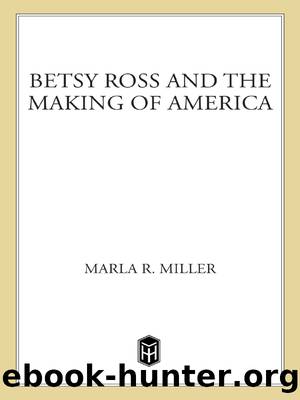Betsy Ross and the Making of America by Marla R. Miller

Author:Marla R. Miller
Language: eng
Format: epub
ISBN: 9780805082975
Publisher: Henry Holt and Co.
By General Subscription,
For the Free Quakers, erected,
In the year of our Lord, 1783,
Of the Empire 8.
Hardware, plastering, glazing and paintingâthe construction of the new meetinghouse engaged artisans around the city. Terrence Smith plastered the walls; John Long glazed the second-floor windowsâsome 140 lights in allâwhile his counterpart Joseph Wirt completed the ground floor.29 Wirt also painted the cornices and Long the rest of the building. The blacksmith Jacob Elkfeldt installed a stove. And, on June 17, 1784, Betsyâs uncle and cousinsâas the firm Abel James & Sonsâaccepted payment for lead, possibly for flashing, or to protect the floor beneath the stove from sparks.30 The final building, the historian Bernard L. Herman has observed, âcomplete with giant engaged pilasters . . . tapped into the worldly and academic language of classicism.â The stylish elements the meeting chose conformed to both an aesthetic of restraint and contemporary architectural fashion, and so (Herman continues) were âconsistent with a Quaker doctrine that emphasizes the importance of the practice of living in the world.â31
When the building was at last readyâor ready enoughâfor a meeting, a âlarge and solemnâ gathering was attended by some two hundred people, including âmost of the members of our Society who resided in this city,â as well as âdivers of our fellow Christians of other denominations.â32 But the interior was not yet finished. The house carpenter Evan Evans still had benches to make in August; as fall went on, the building was further improved when the meeting decided to purchase a small table for the structure and to have Venetian blinds made for the back windowsâtall ones on the western wall to block out the afternoon sun. This latter job went to the upholsterer John Davis, who submitted a bill of £8 for âmounting 2 Vanicion [Venetian] blines 11 feet 3 inches long.â33 Timothy Matlack bought a folio book of the âbest paper, all bound in the best leatherâ for the recording of marriages, and the new meeting was good to go.34
From the beginning, the design of the building included revenue-generating space in the cellar, which was rented out immediately to a wine merchant. But when the congregation did not grow as fast or as large as its founders envisioned, plans were made to create a second floor which could also be rented out for additional income. Brick piers were installed in the cellar and wooden columns above to support another floor, and stairs built along Arch Street to reach the new door that had to be cut through the not-so-old brickwork. Soon, the schoolmaster John Poor alerted potential students to his new âAccommodations for the Instruction of Young Ladiesâ; some one hundred students had enrolled by the end of the year. Poor claimed that his academy was the âfirst in the United States, and perhaps in the worldââmaybe so, for it outgrew these quarters. In Poorâs wake, the upper room of the meetinghouse was rented by the Masonic Lodge, which took a nine-year lease. For those years, the meeting space was particularly convenient to John Claypoole, if he continued to attend meetings.
Download
This site does not store any files on its server. We only index and link to content provided by other sites. Please contact the content providers to delete copyright contents if any and email us, we'll remove relevant links or contents immediately.
Waking Up in Heaven: A True Story of Brokenness, Heaven, and Life Again by McVea Crystal & Tresniowski Alex(37491)
Empire of the Sikhs by Patwant Singh(22769)
We're Going to Need More Wine by Gabrielle Union(18636)
Hans Sturm: A Soldier's Odyssey on the Eastern Front by Gordon Williamson(18329)
Leonardo da Vinci by Walter Isaacson(12807)
The Radium Girls by Kate Moore(11624)
Tools of Titans by Timothy Ferriss(7818)
Educated by Tara Westover(7693)
How to Be a Bawse: A Guide to Conquering Life by Lilly Singh(7159)
Permanent Record by Edward Snowden(5542)
The Last Black Unicorn by Tiffany Haddish(5416)
The Rise and Fall of Senator Joe McCarthy by James Cross Giblin(5151)
Promise Me, Dad by Joe Biden(4909)
The Wind in My Hair by Masih Alinejad(4847)
The Crown by Robert Lacey(4575)
A Higher Loyalty: Truth, Lies, and Leadership by James Comey(4554)
The Iron Duke by The Iron Duke(4124)
Joan of Arc by Mary Gordon(3786)
Stalin by Stephen Kotkin(3726)
